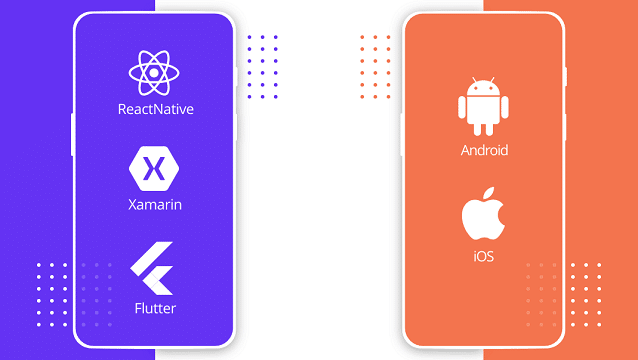The digital landscape is evolving with an impressive acceleration, and within this ever-changing realm, cross platform mobile app development has taken center stage. A strategy that once lingered in the shadows of native development practices now leads the mobile app development trends, thanks to its cost-effectiveness, efficiency, and the seamless user experience it offers across various devices. Let’s embark on a journey through the rise of cross-platform development and how it is reshaping the mobile app industry.
Understanding Cross Platform Mobile App Development
What is Cross Platform Mobile App Development?
Cross platform development is the process of creating software applications that are compatible with multiple mobile operating systems from a single code base. This means developers can write the code once and deploy it across various platforms like iOS and Android, ensuring a wider reach with reduced development time and costs.
The Early Days of Cross-Platform Approaches
Initially, cross-platform solutions were fraught with performance issues, limited access to native APIs, and a subpar user experience. However, with the advent of advanced cross-platform development tools, these issues have been addressed, leading to a surge in popularity.
Cross-Platform vs. Native Development
Native app development involves building apps for specific platforms using languages and tools designed for those ecosystems, which often results in optimized performance but at a higher cost and longer development time. Cross-platform development, on the other hand, prioritizes broader app availability and faster market entry.

Why Cross-Platform Development is Leading Mobile App Development Trends
- Cost-Effectiveness
Cross-platform development can significantly reduce development costs, as it eliminates the need to invest in separate development teams for each platform, streamlining the development process and resource allocation.
- Time Efficiency
With a single codebase to maintain, development timelines are shortened. This efficiency allows businesses to launch their apps faster, which is a critical factor in today’s fast-paced digital marketplace.
- Broader Market Reach
By accommodating multiple platforms, businesses can reach a wider audience, maximizing the potential user base and ensuring no segment is left untapped.
- Easier Maintenance and Updates
Updating and maintaining apps becomes less cumbersome with cross-platform development. A single update can roll out across all platforms, ensuring consistency in performance and user experience.
The Evolution of Cross-Platform Development Tools
The maturation of cross-platform development tools has been a game-changer. These tools have evolved to provide near-native performance and access to device-specific features, making them increasingly popular among developers.
- React Native – Bridging the Gap
React Native, developed by Facebook, is an open-source framework that allows developers to build mobile apps using JavaScript and React. It’s known for its native-like performance and a vast community contributing to its ever-growing ecosystem.
- Flutter – The UI Powerhouse
Flutter, Google’s UI toolkit for crafting natively compiled applications, is gaining traction due to its expressive and flexible UI capabilities that allow for a high level of customization.
- Xamarin – The .NET Advantage
Xamarin, a Microsoft-owned framework, leverages .NET and C# to build apps for Android, iOS, and Windows with a single codebase, appealing to developers familiar with the Microsoft stack.
- Ionic – The Web Technology Prodigy
Ionic uses HTML5, CSS, and JavaScript to build applications, offering a library of components for both iOS and Android, making it an ideal choice for web developers transitioning to mobile app development.

The Impact of Cross-Platform Development on Industry Dynamics
- Streamlining Business Operations
Cross platform mobile apps have allowed businesses to streamline their operations by providing uniform solutions that work across various devices and platforms used within the company.
- Fostering Innovation
With resources freed up by the efficiencies to build cross platform mobile app, businesses can focus more on innovation and improving the user experience, rather than being bogged down by the intricacies of native development.
- Enhancing Competitive Advantage
In a market where speed and presence are vital, cross platform mobile app enable businesses to quickly deploy and update their applications, thus enhancing their ability to compete in the digital marketplace.
The Future of Mobile App Development
As we delve into the intricate fabric of mobile app development, it’s evident that the once stark demarcation between native and cross-platform strategies is blurring. The advent of sophisticated cross-platform tools has catalyzed this transition, nudging the industry towards a more unified and flexible approach to app creation. This shift is not merely a fleeting trend but a signpost of an enduring change in the technological paradigm.
- Embracing Change
To stay at the forefront of the mobile app domain, embracing change is not just beneficial—it’s imperative. Developers and businesses are recognizing that clinging to traditional native development alone limits their reach and adaptability. The modern digital economy demands agility and a broad market presence, both of which are hallmarks of cross-platform development. By adopting these versatile tools, entities can not only streamline their development processes but also harness the potential to innovate and scale with unprecedented efficiency.
- The Role of AI in Cross-Platform Tools
The integration of Artificial Intelligence (AI) into cross-platform development is poised to revolutionize how we conceive and execute app development. AI’s role is becoming increasingly significant, infusing these tools with capabilities such as predictive analytics, automated code refactoring, and intelligent debugging. This infusion of AI is transforming cross-platform tools into not just a means to an end but a dynamic ally in the development process. With AI’s ability to learn and adapt, these tools are constantly evolving, offering smarter recommendations, enhancing developer productivity, and ultimately leading to a more polished and user-centric final product.
- Sustainability in Development
The conversation around sustainability has transcended beyond the traditional realms and has firmly planted its roots in the technology sector. Cross-platform development aligns seamlessly with the ethos of sustainability. By leveraging a single codebase to cater to multiple platforms, developers significantly reduce the redundancy in their work. This reduction not only saves time but also minimizes the digital footprint, embodying a more sustainable approach in contrast to the resource-heavy native development for each platform. In an era where resources are precious, and sustainability is not just desired but demanded, cross-platform development is a beacon of responsible innovation.
- The Educational Shift
Recognizing the shifting sands of the mobile app industry, educational institutions are recalibrating their curricula. The focus is now on equipping students with the knowledge and skills necessary to excel in a market that increasingly values cross-platform expertise. By introducing courses and modules dedicated to cross platform mobile app development frameworks, these institutions are preparing a new generation of developers for a future where flexibility and versatility are not just advantageous but essential. This educational shift is a proactive response to the evolving market demands, ensuring that the upcoming talent pool is not just proficient in current technologies but also adaptable to future advancements.
Conclusion
The rise of cross platform mobile app development represents a paradigm shift in how we create digital solutions. It has democratized mobile app development, making it accessible, affordable, and agile. As the tools continue to improve, we can expect this trend to persist, shaping the future of mobile apps.
For developers and businesses alike, staying informed about the latest mobile app development trends and leveraging cross-platform mobile app development frameworks is no longer an option—it’s a necessity. By embracing this approach, the potential for innovation and growth in the mobile app domain is boundless.
In the spirit of learning and growth, explore more about cross-platform development in our other blog posts or dive into the latest app development trends. If you’re looking to get started with your own app, check out our guide on selecting the right development tools for your project.
We are witnessing not just the rise but the thriving of cross-platform mobile app development, and it’s an exhilarating time to be part of this revolution.
What is a cross platform mobile app?
A cross platform mobile app is an application that can run on multiple operating systems, such as iOS and Android, without requiring significant modifications to the codebase. It allows developers to write the app’s codebase once and then deploy it on different platforms, saving time and effort.
What is the difference between native vs cross platform mobile app?
Native mobile apps are developed specifically for a particular platform, such as iOS or Android. They are built using platform-specific programming languages and technologies, allowing them to take full advantage of the device’s features and performance. Cross platform mobile app, on the other hand, are developed using frameworks that allow the code to be reused across multiple platforms. They offer the advantage of writing code once and deploying it on multiple platforms, but may have limitations in accessing certain device features and performance optimizations compared to native apps.
What is the best stack for cross platform mobile app?
The React Native framework with JavaScript is a popular choice for developing cross platform mobile apps. It allows you to build apps that work on both iOS and Android platforms using a single codebase.
What is the best way to create cross platform mobile app?
The best way to create a cross platform mobile app is by using a framework like React Native or Flutter. These frameworks allow you to write code once and deploy it on multiple platforms such as iOS and Android. They provide native-like performance and access to device features, making them a popular choice for cross platform mobile app development.


